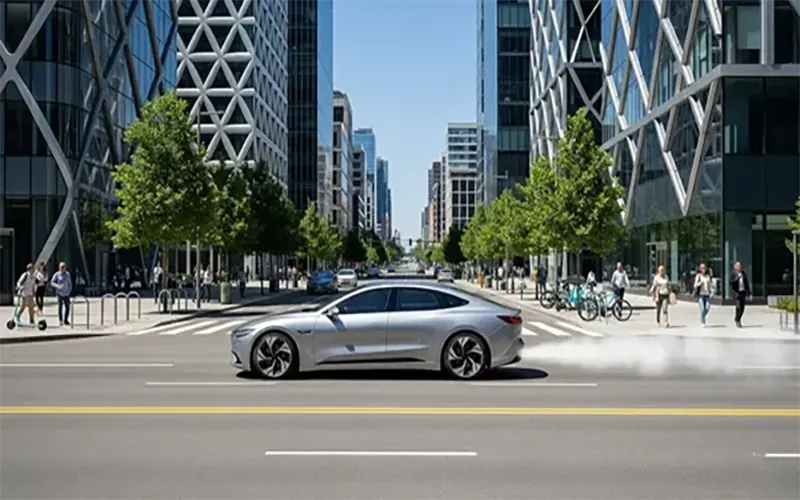The global push for sustainable transportation is driven by the urgent need to address two critical environmental challenges: climate change and urban air pollution. While the conversation often centers on battery electric vehicles (BEVs), hydrogen fuel cell vehicles (FCEVs) offer a powerful and complementary solution, particularly in densely populated urban areas where the air we breathe is most at risk. By fundamentally changing the way vehicles are powered, FCEVs are poised to play a vital role in cleaning up our cities and improving public health.
The Ultimate Zero-Emission Solution
The most significant contribution of hydrogen vehicles to urban air quality is their complete elimination of tailpipe emissions. A traditional gasoline or diesel car is a major source of a noxious blend of pollutants, including:
- Nitrogen Oxides (NOx): These gases contribute to the formation of ground-level ozone, a key component of smog, and are linked to respiratory illnesses and other health problems.
- Particulate Matter (PM): These tiny airborne particles can be inhaled deep into the lungs and bloodstream, leading to serious cardiovascular and respiratory diseases.
- Carbon Monoxide (CO): A poisonous gas that reduces the oxygen-carrying capacity of the blood.
- Unburned Hydrocarbons: These are components of smog and can be carcinogenic.
A hydrogen fuel cell vehicle, by contrast, operates on a simple chemical reaction between hydrogen and oxygen, with the only byproduct being pure water vapor and warm air. This means that a running FCEV contributes absolutely nothing to the atmospheric pollution of a city. For large urban fleets, such as buses, taxis, and delivery trucks, this zero-emission profile at the tailpipe offers an immediate and direct public health benefit.
A Quieter Cityscape
Beyond the unseen threat of air pollution, urban residents are constantly exposed to the pervasive and often harmful effects of noise pollution. The constant roar of thousands of internal combustion engines is a major source of stress, sleep disruption, and hearing loss. Hydrogen fuel cell vehicles, like their battery-electric counterparts, operate almost silently. The hum of an electric motor is a whisper compared to the drone of a diesel engine, fundamentally changing the aural experience of a city street. This reduction in noise pollution leads to a more peaceful urban environment and has significant long-term benefits for the mental and physical well-being of city dwellers.
Ideal for Urban Fleets
While BEVs are a great fit for private passenger cars with predictable routes, FCEVs offer unique advantages for the high-mileage, high-demand vehicles that are the largest contributors to urban air pollution.
- Public Transit Buses: City buses operate on tight schedules and require long-range capability. Hydrogen-powered buses can refuel in minutes, eliminating the need for long charging breaks and keeping them in service throughout the day.
- Taxis and Ride-Share Fleets: For taxis that are constantly in motion, a quick refueling time is critical to maximize uptime and profitability. Hydrogen taxis can operate just like their gasoline predecessors but with zero emissions.
- Heavy-Duty and Delivery Trucks: These vehicles, often the largest source of mobile nitrogen-oxide emissions in urban areas, can leverage the long range and fast refueling of hydrogen to operate efficiently while cleaning up the air.
The Bigger Picture: A Clean Energy Ecosystem
It is important to acknowledge that the environmental benefits of FCEVs are directly tied to the way hydrogen is produced. If the hydrogen comes from fossil fuels, the pollution is simply moved from the tailpipe to the production facility. However, the global push towards “green hydrogen,” produced using renewable electricity from sources like solar and wind, ensures that the entire lifecycle of the fuel is clean.
By integrating FCEVs into a sustainable energy ecosystem, we can:
- Utilize Excess Renewable Energy: Excess electricity from renewable sources can be used to produce hydrogen, which can be stored and used to power vehicles when demand is high or weather conditions are not ideal for generation.
- Decentralize Energy Production: Small-scale hydrogen production and fueling stations can be developed within cities, creating a decentralized and resilient clean energy infrastructure.
Hydrogen vehicles are a powerful and crucial component of the solution for urban air pollution. Their ability to deliver zero tailpipe emissions and quiet operation, combined with their practical advantages for high-demand commercial vehicles, makes them an essential tool for creating healthier, more livable cities for generations to come.

